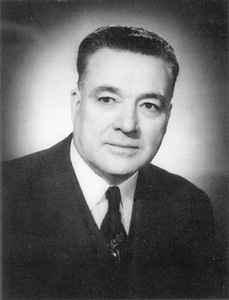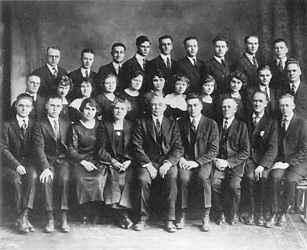
Harold B. Lee |

Harold B. Lee (photo 1959) became a member of the Quorum of the
Twelve
Apostles in 1941 and eleventh President of the Church in 1972
by L. Brent Goatess
Harold Bingham Lee (1899-1973) became the eleventh President of The Church of Jesus Christ of Latter-day Saints on July 7, 1972, and served until his death on December 26, 1973. His 538-day tenure was the shortest service by a Church President in history, despite the fact that at age seventy-three President Lee was the youngest person to hold the office initially in nearly forty years. One of his greatest contributions to the Church, the organization of the correlation program, was made when he was still a member of the Quorum of the Twelve Apostles.
President Lee was born on March 28, 1899, in Clifton, Idaho, to Samuel Marion Lee and Louisa Emiline Bingham. He grew up in impoverished, rural conditions, and from childhood he advanced faster than his peers. He started school a year earlier than was the practice in his farming community because he could already write his name and knew the alphabet. As a young boy, he was large for his age, and when his friends were ordained to the priesthood, he became a deacon also, although he was technically not quite old enough for the honor.
In keeping with this pattern, he began his career in education at a young age. He earned a teaching certificate at Albion State Normal School in Idaho, and at seventeen was appointed to be principal of the one-room Silver Star School at Weston, Idaho, teaching twenty to twenty-five pupils, ranging from first to eighth grade. One year later, he was appointed principal of the larger grade school at Oxford, Idaho, where he served for three winters.
These responsibilities prepared him for his call in 1920 to the Western States Mission, headquartered in Denver, Colorado. After nine months he became conference president, presiding over both missionaries and local Church members in Denver. During his two year missionary service, he baptized forty-five converts to the Church.
President Lee was one of the youngest stake presidents in the Church when at thirty-one, he was set apart as president of Pioneer Stake in Salt Lake City. Within a few years, he was faced with the suffering among stake members brought on by the Great Depression. With his counselors, he struggled to save his people from hunger and financial ruin. His ingenuity in helping them obtain basic necessities led to his appointment by the First Presidency in 1935 to organize a Welfare program for the entire Church.
In 1932 President Lee was appointed to fill a vacancy in the Salt Lake City Commission and was assigned to direct the Department of Streets and Public Improvements. A year later, he was elected to the same position. For years Utah citizens urged him to run for the governorship or for the U.S. Senate.
Elder Lee was called as a member of the Quorum of the Twelve Apostles on April 6, 1941. As he looked around the council room in the Salt Lake Temple where the quorum held its meetings, Elder Lee, then forty-two, discovered that every man there was at least twenty years his senior. He thought of himself as a seedling among giant redwoods, causing his tutor and friend J. Reuben Clark, Jr., a counselor in the First Presidency, to refer affectionately to him as the "Kid."
Early in his apostleship, Elder Lee served on a committee to simplify Church organization and functions. For two decades, he studied the subject and prepared proposals. Finally when the time for implementing them came in the 1960s, the correlation program was introduced, with Lee serving as chairman of the Correlation Committee. Correlation emphasized the family and the home, the connection of auxiliary organizations with the priesthood, simplification of the curriculum, the teaching of the scriptures, and restructuring the Church magazines to serve children, youth, and adults better.
In January 1970, Elder Lee was called to serve as a counselor in the First Presidency while concurrently presiding over the Quorum of the Twelve Apostles. He was called to be president of the church after President Joseph Fielding Smith died on July 2, 1972.
Following a long period when age and illness had prevented the previous Church Presidents from traveling, President Lee moved out among the people. He attended area conferences in England, Mexico, and Germany. President Lee also conscientiously and purposefully devoted much time to address youth conferences, to restore the prophetic image to the young members of the Church. He was the first to visit Israel and Palestine as President of the Church.
President Lee possessed a remarkable candidness about himself and the office of President. He talked openly of his feelings about his calling, allowing people to look into his heart. Sensitive spirituality was his greatest leadership quality. He sought answers to prayers for the Saints and boldly labeled the answers revelations. He was a forceful preacher of the gospel. His sermons were always based upon solid scriptural foundations, and yet the lessons were invariably illustrated with poignant and often tender stories of everyday life, appropriate to the day and its challenges. His counsel was practical; for him the most important commandment was the one a person was having difficulty living at the moment.
President Lee's spirituality resulted partly from his personal struggles. He learned to control a fiery temper and a quick, action-oriented disposition that had earlier in his life offended some. In his later years, President Lee was perceived as being more gentle in manner, compassionate, gracious, hospitable, and thoughtful of others. He was always a gentleman, impeccably dressed. At age seventy-four he served as though in the prime of life, with a rich, full voice and characteristic vigor. His sudden death on December 26, 1973, from cardiac and lung failure stunned the Church.
President Lee found great pleasure, and also experienced sorrows, in his family. In 1923 he married Fern Lucinda Tanner, whom he first met in the Western States Mission. To them were born two daughters, Maurine and Helen. They had ten grandchildren. Fern died September 24, 1962, and Maurine died shortly thereafter, making this a difficult period in President Lee's life. He married Freda Johanna (Joan) Jensen, an educator, on June 17, 1963.
In the conference meeting in which he was sustained as President of the Church, President Lee characterized his own life: "At times it seemed as though I, too, was like a rough stone rolling down from a high mountainside, being buffeted and polished, I suppose, by experiences, that I, too, might overcome and become a polished shaft in the quiver of the Almighty" (CR, Oct. 1972, p. 20).
(See Daily Living home page; Church History home page; People in Church History home page)
Illustrations

Twenty-two-year-old Harold B. Lee, seated to the right of mission
president John M. Knight, served
as president of the Denver Conference of the Western States Mission (photo of the Denver
Conference, 1921).
Bibliography
Arrington, Leonard J. "Harold B. Lee." In, The Presidents of the Church, ed. Leonard J. Arrington, pp. 342-71. Salt Lake City, 1986.
Goates, L. Brent. Harold B. Lee, Prophet and Seer. Salt Lake City, 1985.
Goates, L. Brent. He Changed My Life. Salt Lake City, 1988.
Encyclopedia of Mormonism
Copyright © 1992 by Macmillan Publishing Company
All About Mormons |